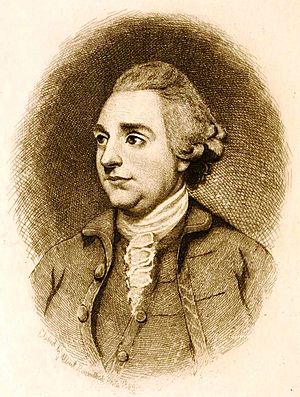Hugh Waddell (general) facts for kids
Quick facts for kids
Hugh Waddell
|
|
|---|---|

Portrait of Hugh Waddell, from Alfred Waddell's A Colonial Officer and His Times
|
|
| Born | c. 1734 Lisburn, County Down, Ireland |
| Died | 9 April 1773 (aged 38–39) Castle Hayne, North Carolina |
| Buried | |
| Allegiance | Province of North Carolina, Kingdom of Great Britain |
| Service/ |
Provincial Troops |
| Years of service | 1754–1773 |
| Rank | General |
| Battles/wars | |
| Relations | James Iredell Waddell, great-grandson Alfred Moore Waddell, third-great-grandson |
General Hugh Waddell (born around 1734 – died April 9, 1773) was an important military leader. He lived in the Province of North Carolina when it was controlled by Great Britain. Waddell helped create and lead a local army unit, called a militia, in Rowan County, North Carolina. He also served in the Ohio River Valley. He fought in the French and Indian War and the Anglo-Cherokee War. He also oversaw the building of Fort Dobbs near the Fourth Creek Congregation. His career was helped by his strong connections to North Carolina's governors.
Contents
Early Life and Beginnings
Waddell was born around 1734 in Lisburn, County Down, Ireland. His parents were Hugh and Isabella Brown Waddell. They were from a group called Ulster Protestants. We don't know his exact birth date. In 1753 or 1754, Waddell moved to the colonies. This happened because he was a friend of Arthur Dobbs, who became Governor of North Carolina. Waddell joined the army as a lieutenant under the acting Governor, Matthew Rowan.
French and Indian War Service
In 1754, Waddell went to Virginia. He served under Colonel James Innes. Innes was the commander of all colonial forces in Virginia. Waddell didn't see any fighting there. But he was promoted to captain. He returned to North Carolina in late 1754.
He then spent a lot of time building and maintaining Fort Dobbs. This fort was near what is now Statesville, North Carolina. In 1756, Waddell was asked by Virginia's Lieutenant Governor Robert Dinwiddie to be a "Commissioner of Peace." This meant he would talk with the Cherokee and Catawba tribes. Waddell was the only person from North Carolina in these talks. He helped get these tribes to temporarily work with the British against the French.
In 1758, Waddell, who was now a major, joined General John Forbes. He led 300 rangers in the Forbes Expedition. Their goal was to capture Fort Duquesne. Waddell's rangers first worked as scouts and guards. On September 14, 1758, they were among several groups attacked. A raiding party of Shawnee and Delaware warriors ambushed them. Waddell's unit fought back successfully. Other units attacked at the same time ran away.
On November 12, 1758, General Forbes ordered Colonel George Washington to attack Fort Duquesne. Waddell and his troops fought off French-allied native warriors for four days. By November 24, 1758, Waddell's scouting force arrived at Fort Duquesne. They found that the French soldiers had destroyed the fort. The French had decided to leave the fort because of the Forbes Expedition's strong attack. After this, Waddell became a Colonel. He and his rangers went back to Fort Dobbs. They defended the Carolina area against the Cherokee, who were becoming more aggressive.
Fighting the Cherokee
Waddell was at Fort Dobbs on the night of February 27, 1760. A group of Cherokee attacked the fort. This was the only battle that happened at Fort Dobbs. During the fight, between 10 and 12 Cherokee were hurt. Two British soldiers were also wounded.
War of the Regulation
After the Treaty of Paris in 1763, Waddell led local militia. He supported Governor William Tryon. This meant he was against the "Regulation" movement. The "Regulation" movement was a group of people protesting against unfair taxes and government actions. Waddell did not fight in the Battle of Alamance. This was because Regulator militia had surrounded him near Salisbury, North Carolina. Governor Tryon marched west partly to help Waddell.
Later Life and Legacy
Waddell served in the North Carolina Legislature several times. He represented Rowan County. However, his main homes were in Bladen County and Brunswick County. Even though he had supported Governors Dobbs and Tryon, he was not chosen for the Governor's Council. This council was the main group that advised the colonial Governor.
During this time, Waddell helped start a group called the Sons of Liberty in the Wilmington area. He also took part in protests against the Stamp Act of 1765. This act was a tax from Britain that many colonists disliked.
Hugh Waddell died on April 9, 1773. He had been sick for a long time. He passed away in Castle Hayne, North Carolina, where he is buried.
General Waddell was an ancestor of James Iredell Waddell. James was a Confederate captain during the Civil War. He was also an ancestor of Alfred Moore Waddell. Alfred was a United States Congressman from North Carolina. He wrote a book about General Waddell in 1890. In his book, Alfred Waddell said that the General had served in the military longer than any other officer in the province. This made him the most important soldier of his time.


